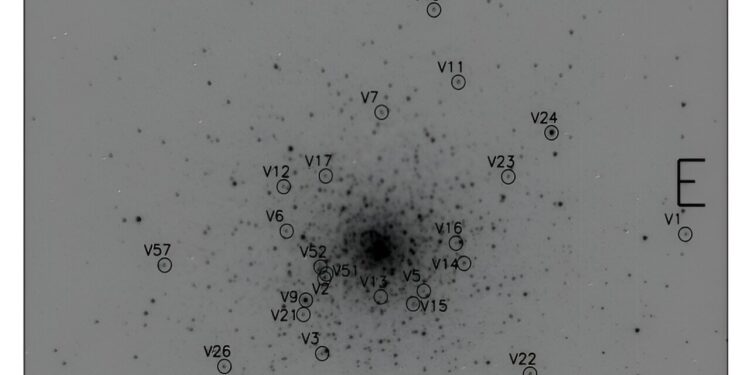Identification map of variable stars in the NGC 1851 field. Credit: Ferro et al., 2024.
Astronomers have made photometric observations of a young globular cluster known as NGC 1851. The new observation campaign provides more information about the variable star population in this cluster and validates the membership of these variable stars. The results were published on August 20 on the preprint server arXiv.
The detection and study of variable stars could provide important information about some aspects of the structure and evolution of stars. The study of variable stars could also contribute to a better understanding of the distance scale of the universe.
Globular clusters (GCs) are collections of tightly bound stars orbiting galaxies. Astronomers consider them natural laboratories for studying the evolution of stars and galaxies. In particular, globular clusters could help researchers better understand the history of early-type galaxy formation and evolution, because the origin of GCAs appears to be closely linked to periods of intense star formation.
NGC 1851 (also known as Caldwell 73) is a remarkably bright and massive galaxy cluster located about 39,000 light-years from Earth. The cluster is about 9.2 billion years old, has a metallicity of -1.27 dex, and is estimated to have a mass of 551,000 solar masses.
Previous observations of NGC 1851 have shown that it contains 48 RR Lyrae variable stars and that it may harbor four or five long-period variable stars near the tip of the red giant branch (RGB).
That is why a team of astronomers led by Armando Arellano Ferro, from the National Autonomous University of Mexico, decided to explore the population of variables of NGC 1851, in the hope of completing the census of these objects in this GC. For this, they used the Astronomical Observatory of Córdoba, in Argentina.
Overall, the observations conducted by Ferro’s team revealed that of the 55 variable stars in NGC 1851 originally listed in previous variable star catalogues, eight were clearly found to be field stars. In addition, for six other variables, membership in this category could not be confirmed due to the lack of proper motion or merger with bright neighbouring stars.
The observations detected three variables that had not been previously identified. However, only one of them, called V56, turned out to be a member of the cluster. The researchers classified this star as an SX Phoenicis variable.
In addition, the study confirmed the variability of two Lyrae RRs of the RRab subtype and three long-period variables, which were reported by previous Gaia satellite observations. Since these five variables were validated as members of the group, they were given the designations V57–V61.
Based on the light curves of the RR Lyrae variables identified in NGC 1851, the researchers calculated that the metallicity of this cluster is about -1.35 dex and that the GC is located at a distance of 38,800 light-years.
More information:
A. Arellano Ferro et al, The variable star population of the young extended globular cluster NGC 1851, arXiv (2024). DOI: 10.48550/arxiv.2408.11141
Journal information:
arXiv
© 2024 Science X Network
Quote: Research examines the variable star population of the globular cluster NGC 1851 (2024, August 28) retrieved August 28, 2024 from
This document is subject to copyright. Apart from any fair dealing for the purpose of private study or research, no part may be reproduced without written permission. The content is provided for informational purposes only.



